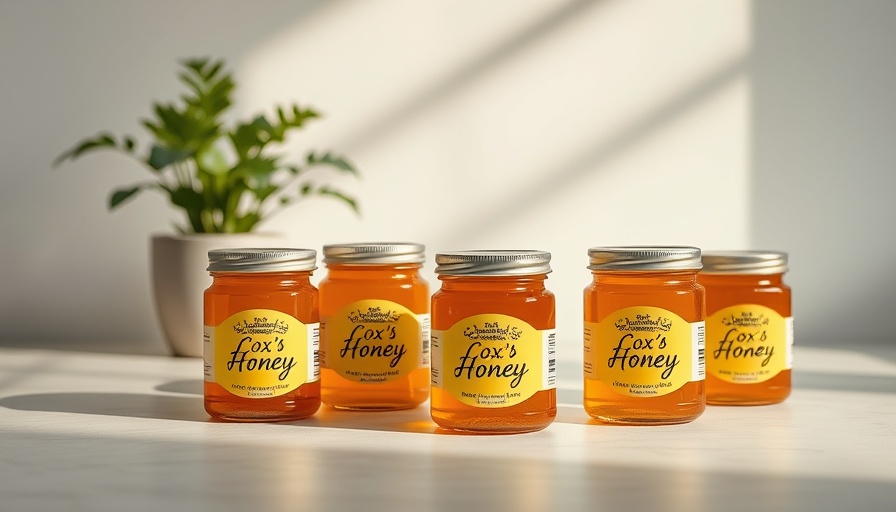
Why Honey Is a Must-Have in Your Pantry
Honey, a natural sweetener and medicinal powerhouse, has made its mark in kitchens and health circles alike. This sweet golden liquid not only brings flavor to your favorite dishes but also delivers a multitude of health benefits, making it essential for every urban and suburban home. Here are some compelling reasons why you should always keep honey in your pantry.
The Incredible Natural Sweetener
At the forefront of honey's charm is its role as a natural sweetener. As a healthier alternative to processed sugars, honey is ideal for sweetening beverages like tea and coffee or for baking mouthwatering desserts. The unique flavor profile of honey offers a mellow sweetness that processed sugars simply can't match. Through its versatility, honey can transform even the simplest recipes into something extraordinary.
Boost Your Immune System Naturally
What if you could enhance your immunity with a simple ingredient? Honey does just that! Packed with antioxidants and antimicrobial properties, honey can be a nutritious addition to your diet, potentially reducing your likelihood of infections. Consuming honey regularly not only satisfies your sweet tooth but also strengthens your body’s defenses.
A Natural Remedy for Coughs
If you find yourself plagued by an incessant cough, a spoonful of honey might just be your remedy. Its soothing nature alleviates throat irritation and helps reduce the urge to cough, giving you the relief you need, especially during cold seasons.
Energy Booster When You Need It Most
In need of a quick pick-me-up? Honey is a fabulous energy booster, thanks to its natural sugars, primarily fructose and glucose. Whether you’re in the middle of a workout or experiencing an afternoon slump, just a tablespoon of honey can give you that uplifting energy! Incorporating honey into your pre or post-workout routine could enhance your performance and recovery.
The Healing Power of Honey
Honey has been revered for centuries for its wound-healing properties. Due to its antibacterial and anti-inflammatory abilities, applying honey topically can expedite the healing process for minor wounds and burns. Always consult with your healthcare provider for serious injuries, but for minor situations, honey is an effective first aid ally.
Allergy Relief Through Local Honey
For those suffering from seasonal allergies, local raw honey offers a unique solution. By containing trace amounts of local pollen, consuming local honey might work to desensitize your body against allergens, making it an intriguing choice for allergy sufferers.
A Digestive Aid Like No Other
Honey also shines as a digestive aid. Its mild laxative effect can ease constipation, while its prebiotic characteristics support gut health, making it a gentle and natural way to foster digestive wellness.
Natural Skincare Marvel
Beyond the kitchen, honey serves as an excellent ingredient in skincare. Its moisturizing properties make it perfect for homemade masks and scrubs that can nourish and hydrate your skin. A honey-based skincare regimen can make your complexion glow and support skin health.
Fostering a Sustainable Lifestyle
Embracing the use of honey not only enriches your pantry but can also be a step towards a more sustainable lifestyle. Supporting local beekeepers helps revive bee populations, which is crucial for our ecosystem. Honey thus embodies the principles of sustainable living and responsible consumption.
Intentional Consumption for Better Health
Incorporating honey into your diet is a celebration of intentional eating. Health-focused consumers can greatly benefit from understanding the natural ingredients they use daily. With honey, not only are you stocking your pantry with a versatile ingredient, but you're also making a conscious choice to prioritize your health.
Conclusion: Stock Up on Honey Today!
Whether for its taste, health benefits, or sustainability aspects, honey is truly a wonder ingredient that deserves a spot in your pantry. From its historical significance to its practical applications today, honey can enhance lives in many ways. So, take the plunge and stock up on this gold liquid—your body will thank you!
 Add Row
Add Row  Add
Add 




 Add Row
Add Row  Add
Add 

Write A Comment